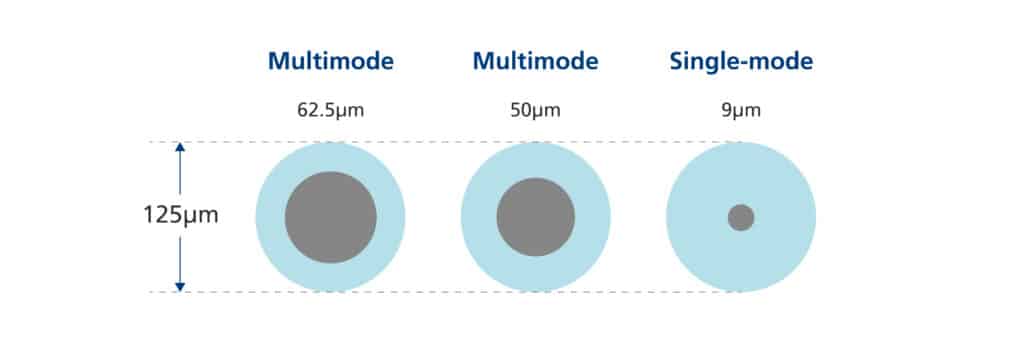Optical fiber cable transmits data as light at speeds exceeding 100 Gbps, far surpassing the 10 Gbps capabilities of legacy Cat 6A copper cable. Additionally, optical fibers support significantly higher bandwidths over greater distances without signal degradation. Due to the vast difference in performance between modern optical fiber cabling and outdated copper technologies, fiber optic connectivity has emerged as the preferred solution for global businesses seeking secure, rapid, reliable communication.
To meet project requirements and ensure high performance across varying installation environments, manufacturers offer a wide range of application-specific optical fiber cables. For example, Plastic Optical Fiber (POF) comprises a plastic core, which offers an increased bend radius for compact installations. However, POF is less efficient in terms of bandwidth compared to optical fiber cables.
The two main types of optical fiber cables are single-mode fiber (SMF) and multimode fiber (MMF). Whereas hair-thin single-mode fibers send light along one pathway, multi-mode fibers have a slightly larger core diameter allowing multiple light paths in the same cable. This blog explores the key differences between these technologies and provides guidance on choosing between SMF and MMF when building an advanced hyperscale network.
Core principles

SMF’s comparatively narrow core channels light signals along a single pathway. The design minimizes ‘modal dispersion’ (i.e., signal overlap that can confuse the receiver) enabling long-distance connectivity without requiring signal regeneration from optical repeaters mid-transmission. In contrast, wider-core MMF cables offer multiple light paths, making MMF prone to modal dispersion over long distance but ideal for short-distance, high-bandwidth connections.
The increasing global appetite for rapid access to data places greater demand on data center efficiency, with the need for higher bandwidth and lower latency pushing current MMF technologies to the limit.
Key differences between SMF and MMF
The following table highlights the key differences between SMF and MMF cables, highlighting the significant variance in applications linked to performance.
| Single-mode fiber (SMF) | Multimode fiber (MMF) | |
|---|---|---|
| Core size (micrometers) | 9 | 50 or 62.5 |
| No. of modes (light channels) | 1 | 1000+ |
| Optimal use | Long distance | Short distance |
| Distance capabilities | 40 km (or more) | 550 meters at 1Gbps / 300 meters at 10 Gbps |
| Bandwidth | 100 Gbps and beyond | 10 Gbps – 400 Gbps (OM1 – OM5) * |
Why choose single-mode fibers

As shown in the table, single-mode fibers offer several key tactical advantages over multimode fibers in relation to delivering high-bandwidth, low-attenuation connectivity. Due to SMF’s narrow core, a single mode of light can transmit over tens of kilometers, without requiring signal boosters or repeaters.
This defining characteristic of SMF technology makes these cables the ideal choice for various applications, including:
- Cable television
- Internet services
- Telecommunications
- Metropolitan Area Networks (efficiently connecting networks within a town/city/campus)
- Data centers (although counterintuitive, long-distance SMF technology has revolutionized connectivity within hyperscale data centers – see below for more information)
Additionally, due to SMF’s high sensitivity and accuracy, the technology can be found in fiber optic sensors across various industrial and environmental monitoring applications.

Multimode technology offers many strategic advantages over short-distances in high-bandwidth applications. Comprising a larger core diameter than single-mode fibers, multimode supports the simultaneous propagation of various light signals, ideal for high data throughput over short distances. This unique attribute of MMF connectivity means the technology is ideal for many scenarios, including:
- Data centers
- Local Area Networks
- Enterprise networks / corporate environments
Comparatively, MMF also presents a more cost-effective option than SMF. This is due to several factors, including the use of cheaper LED-based light sources (SMF uses more expensive laser diodes), lower component costs (in line with less stringent manufacturing considerations), and simplified, expedited maintenance costs (MMF’s larger cores are easier to align, splice, and maintain, reducing installation times and minimizing the need for specialized tools).
SMF vs MMF – selecting the right cable for your needs
Budget can be a determining factor in deciding data center hardware. However, there are arguably three main variables that hyperscalers must consider when selecting between SMF or MMF:
Distance: SMF is preferred
Single-mode technology also provides enhanced performance over distance. Standout characteristics such as lower signal attenuation, minimized data dispersion, and higher bandwidth all make SMF the preferred cabling choice for applications requiring consistent, reliable performance over long distance.
Bandwidth requirements (short distance): MMF is preferred
As shown in the above table, MMF’s larger core diameter (ranging from 50 to 62.5 micrometers) in comparison to single-mode’s 9 micrometer diameter translates into greater raw bandwidth. For example, MMF’s OM4 and OM5 cables can manage transmission rates of around 100 Gbps over distances of 100 meters and 150 meters respectively. In contrast, SMF supports similar rates over distances exceeding 10 kilometers.
Conclusion: The coming shift toward SMF and WDM
Wavelength Division Multiplexing (WDM) transmits multiple signals over SMF fibers, converting the previously single-mode fiber into a multi-lane expressway supporting virtually limitless bandwidth.
While MMF remains the prevailing cost-effective solution over short-reach connections (i.e., within data center racks), the increasing demand for access to data and data-intensive applications positions WDM and SMF – with its enhanced bend radius and superior bandwidth – as the preferred choice for hyperscalers architecting the data centers of tomorrow.
Ultimately, choosing between SMF and MMF hinges on factors such as network requirements, financial constraints, and the desire to embrace SMF and WDM technology to remain ready for the challenges ahead.
Keep learning: Grow your knowledge about Advanced Networks for Artificial Intelligence and Machine Learning Computing.







